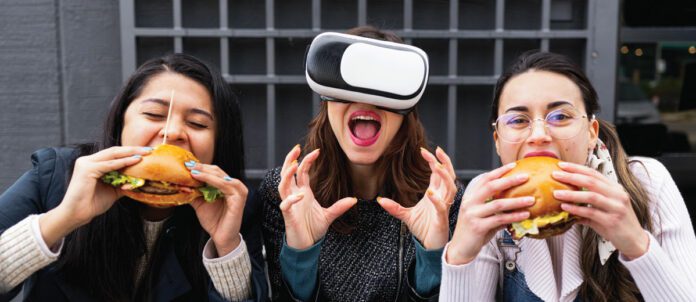With the projected market size of augmented reality/virtual reality (AR/VR) expected to rise to more than USD $250 billion by 2028, according to Statista, it’s only natural to ask what the implications are for the foodservice industry. This technology can change the face of food-and-beverage service by making the experience more personal and enjoyable for customers; in staff training to improve efficiency; for menu enhancement to increase variety; and in advertising to increase customer engagement.
Virtual reality is a computer-generated environment that the user can see through head-mounted devices such as goggles. In contrast, AR technology allows an individual to see a three-dimensional image of reality overlayed with a user’s physical environment. This technology is being used in various settings, but in restaurants, it’s changing how we eat. Here are four examples of how VR/AR can be used to increase profitability in restaurants.
The 3D Gastronomy Experience
Immersing guests in a virtual reality experience makes them feel like they’re in another place, making the dining experience more unique and personal. Some restaurants use AR technology to create atmospheres that cannot be replicated in the real world. For example, Hiptoro, a restaurant in France, entertains its guests using 3D imaging while customers wait for their food to arrive. A holographic chef, no larger than one’s thumb, emerges from the table with a greeting and then creates the dish guests are about to eat in a comically creative and entertaining skit. With sound effects and ingredients being flung onto each patron’s dish, this unique dining experience demonstrates how, rather than just focussing on the food, customers are left with an incomparable experience.
Improving Staff Training
According to Statista, the compound annual growth rate (CAGR) for AR/VR on-site and safety-purposes use is projected at 174.4 per cent by 2023.
Lorne Fade, co-founder and COO of Toronto-based VR Solutions, says VR is ideal for training staff without investing much in a training program. “Training can be done anywhere in the world with a hands-on, step-by-step approach where employees can learn at their own pace in a fully interactive environment,” Fade says. “Employees can practice real-world experience in a safe environment where the risk of injury is eliminated and where people can learn cooking techniques at their own pace.”
On the Menu
AR can be a powerful tool in a restaurant’s arsenal when it comes to creating custom menus for their customers. Many restaurants are already using digital QR-code technology instead of paper menus. The Mexican group, Wahaca was the first restaurant in the U.K. to implement such a menu. Customers can navigate through pictures and descriptions of dishes and access information on each dish’s ingredients, allergens and portion sizes.
Customers can feel confident in making well-informed food choices, with customer engagement being achieved within a minimum amount of effort and time and with the convenience of ordering and paying for their meals without leaving their tables.
Advertising the Experience
Advertising is a significant component of every business. Virtual reality provides a unique way to experience products and services while improving customer engagement by creating an experience rather than a product.
Beverage supplier Coca-Cola partnered with WWF to bring the Arctic to the Science Museum London in 2013. By bringing the virtual Arctic closer to home, the company could educate its customers and showcase its environmentally friendly practices, all while allowing people to explore the environment and understand how climate change affects it.
Virtual reality is quickly gaining strides and is set to re-define the food industry. With the potential to revolutionize the way we eat and the way we serve our customers, implementing the technology gives operators the opportunity to see a drastic increase in customers and profits.
BY SUZANNE CHIN-LOY


















